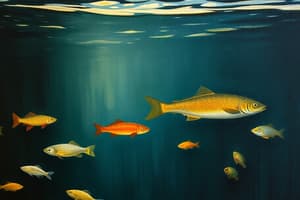Podcast
Questions and Answers
Which of the following is not a component of an ecosystem?
Which of the following is not a component of an ecosystem?
- Biotic
- Producers
- Consumers and decomposers (correct)
- Abiotic
What is the primary source of energy in the forest ecosystem shown in the diagram?
What is the primary source of energy in the forest ecosystem shown in the diagram?
- Water
- Carbon dioxide
- Glucose
- Sunlight (correct)
In the food chain shown, which organism is the primary producer?
In the food chain shown, which organism is the primary producer?
- Decomposers
- Herbivores
- Plants (correct)
- Carnivores
Which of the following is not a way that energy flows through an ecosystem?
Which of the following is not a way that energy flows through an ecosystem?
What is the role of decomposers in the forest ecosystem?
What is the role of decomposers in the forest ecosystem?
How does energy flow through the different trophic levels in the forest ecosystem?
How does energy flow through the different trophic levels in the forest ecosystem?
What is the primary function of producers in an ecosystem?
What is the primary function of producers in an ecosystem?
Which of the following organisms is considered a detritivore in an ecosystem?
Which of the following organisms is considered a detritivore in an ecosystem?
In a food chain, which level of consumers would be classified as a tertiary consumer?
In a food chain, which level of consumers would be classified as a tertiary consumer?
What is the main role of decomposers in an ecosystem?
What is the main role of decomposers in an ecosystem?
How does energy flow through a food chain?
How does energy flow through a food chain?
What would happen in an ecosystem if decomposers were removed?
What would happen in an ecosystem if decomposers were removed?
In the context of energy transfer, why does energy become increasingly concentrated in smaller amounts of biomass as it moves up the food chain?
In the context of energy transfer, why does energy become increasingly concentrated in smaller amounts of biomass as it moves up the food chain?
Why is it crucial for decomposers to break down dead organisms in an ecosystem?
Why is it crucial for decomposers to break down dead organisms in an ecosystem?
What happens to most of the available energy as it moves through different trophic levels in an ecosystem?
What happens to most of the available energy as it moves through different trophic levels in an ecosystem?
Which statement best explains why organisms can survive in an ecosystem without directly relying on the sun's rays for energy?
Which statement best explains why organisms can survive in an ecosystem without directly relying on the sun's rays for energy?
Flashcards are hidden until you start studying
Study Notes
Ecosystems and Food Chains
Ecosystems refer to communities of living organisms interacting with each other and their environment. These interactions involve physical and biological factors such as nutrient cycling, energy flow, and waste management. An ecosystem is composed of two main components: biotic (living) and abiotic (nonliving). The biotic components can further be categorized into producers, consumers, and decomposers. Producers are those organisms that produce their own food using sunlight, water, and carbon dioxide (like plants), while consumers rely on other organisms to obtain their sustenance. Decomposers break down dead organic matter, returning it to the soil.
Food chains illustrate how these different species within an ecosystem interact with each other through feeding relationships. They show how energy flows from one trophic level to another. In an ecosystem, there may be several interconnected food chains. For example, consider a forest ecosystem:

In this diagram, sunlight acts as the primary source of energy. Plant production occurs through photosynthesis, which uses sunlight to convert carbon dioxide and water into glucose. This plant becomes the prey for herbivores, who consume them to gain energy. Herbivores are then eaten by carnivores, providing them with energy. Finally, scavengers feed on the dead animals and recycle nutrients back into the soil, completing the cycle of life.
Food chains are important because they help maintain balance within ecosystems. Predators regulate their prey populations to prevent overgrazing by herbivores, which can harm plant growth. If consumers become too numerous, they may deplete resources, ultimately affecting other species and disrupting the equilibrium. Therefore, understanding food chains and their role within ecosystems helps us appreciate the complex relationships among living organisms and their environment.
Studying That Suits You
Use AI to generate personalized quizzes and flashcards to suit your learning preferences.




